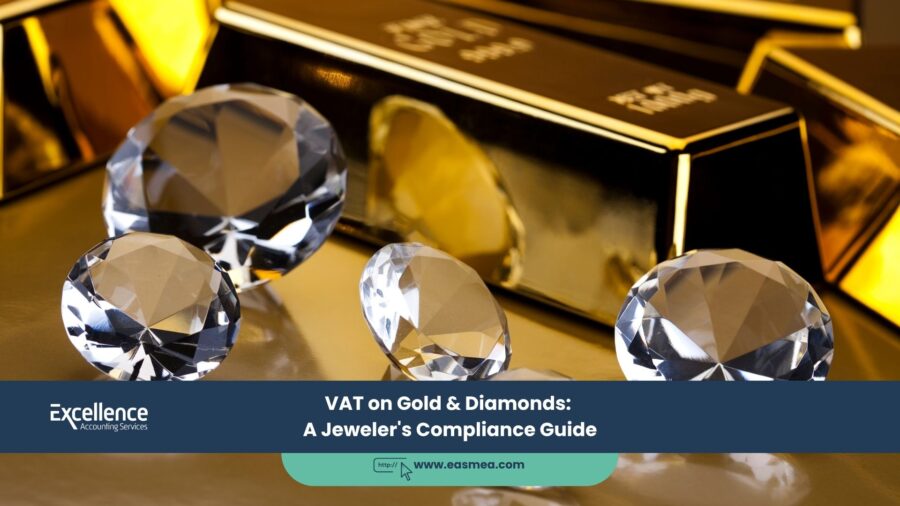VAT on Gold & Diamonds: A Jeweler’s Compliance Guide
The gold and diamond trade is one of the UAE’s most iconic and economically significant sectors, a glittering cornerstone of its reputation as a global hub for luxury goods. However, for jewelers, manufacturers, and wholesalers, the introduction of VAT brought with it a uniquely complex set of rules that go far beyond the standard 5% tax. The distinction between investment-grade metals and finished jewelry, coupled with the special Domestic Reverse Charge Mechanism, creates a compliance landscape that is intricate and fraught with risk.
- VAT on Gold & Diamonds: A Jeweler's Compliance Guide
- Part 1: The Zero-Rated Category - Investment Grade Precious Metals
- Part 2: The Standard 5% Rule - Jewelry, Diamonds, and Services
- Part 3: The Domestic Reverse Charge Mechanism (RCM) - A Critical Concept
- Part 4: Invoicing and Record-Keeping - The Jeweler's Compliance Backbone
- How Excellence Accounting Services (EAS) Supports the Jewelry Sector
- Frequently Asked Questions (FAQs) for Jewelers
- Ensure Your Jewelry Business is Compliant and Protected
Misunderstanding these nuances is not an option. An error in classifying a supply or failing to apply the reverse charge mechanism correctly can lead to significant financial penalties, cash flow disruptions, and disputes with both suppliers and the Federal Tax Authority (FTA). This definitive guide is designed for the UAE jeweler. We will break down the specific VAT treatments for different products, demystify the reverse charge mechanism with practical examples, and provide a clear roadmap for invoicing, record-keeping, and overall compliance, ensuring your business shines as brightly as the products you sell.
Key Takeaways for Jewelers on VAT Compliance
- Investment Gold is Special: The first supply of investment-grade gold, silver, and platinum (meeting specific purity criteria) is zero-rated (0% VAT).
- Jewelry is Standard-Rated: All finished jewelry, diamonds, gemstones, and making charges are subject to the standard 5% VAT rate.
- Domestic RCM is Mandatory for Wholesale: When a VAT-registered business sells precious metals to another VAT-registered business for resale, the supplier does not charge VAT; the buyer must account for it under the Domestic Reverse Charge Mechanism.
- Immaculate Records are Non-Negotiable: The unique rules require meticulous documentation, including supplier/customer declarations for RCM, purity certifications, and separate tracking of different supply types.
- Full Input Tax Recovery: Since nearly all supplies in the jewelry sector are taxable (either standard-rated or zero-rated), businesses can typically recover 100% of the VAT incurred on their legitimate business expenses.
Part 1: The Zero-Rated Category – Investment Grade Precious Metals
The UAE government, recognizing the country’s role as a global bullion hub, created a special VAT treatment for investment-grade precious metals to ensure the market remains competitive. The first supply of these metals after their production or refining is zero-rated.
What Qualifies as “Investment Grade”?
For a precious metal to be treated as “investment grade” and qualify for the zero rate, it must meet two strict criteria:
- Purity: It must have a purity of 99% or greater.
- Tradable Form: It must be in a form that is tradable on the global bullion markets (e.g., bars, ingots, or coins).
| Metal | Minimum Purity for Zero-Rating | Examples |
|---|---|---|
| Gold | 99.5% or higher | 24-karat gold bars, certain gold coins. |
| Silver | 99.9% or higher | Pure silver bars and ingots. |
| Platinum | 99.0% or higher | Investment-grade platinum bars. |
It is crucial to understand that this zero-rating only applies to the metal itself. Any services associated with it, such as delivery, storage, or assaying fees, are subject to 5% VAT.
Part 2: The Standard 5% Rule – Jewelry, Diamonds, and Services
Outside of the narrow definition of investment metals, nearly every other product and service in the jewelry sector is subject to the standard 5% VAT rate. There is often confusion here, but the rules are clear.
Goods and Services Subject to 5% VAT:
- Finished Jewelry: Any item of jewelry, regardless of the purity of the gold or platinum used (e.g., 18k, 21k, 22k gold rings, necklaces, bracelets).
- Diamonds and Gemstones: All loose or set diamonds, pearls, rubies, sapphires, and other precious stones.
- Making Charges: The labor and design cost added to the price of the metal is always a standard-rated service. You must clearly show the VAT on this component.
- Repairs and Other Services: Jewelry repair, polishing, and valuation services.
- Second-hand Jewelry: The sale of pre-owned jewelry is also standard-rated.
Example: A Customer Buys a Gold Necklace
A jeweler sells a 22k gold necklace. The price is composed of AED 5,000 for the gold content and AED 1,000 for the making charge. The entire sale amount of AED 6,000 is subject to 5% VAT. The jeweler must charge the customer AED 6,000 + AED 300 (VAT) = AED 6,300.
Part 3: The Domestic Reverse Charge Mechanism (RCM) – A Critical Concept
To combat potential fraud in the high-value precious metals wholesale market, the FTA implemented a special Domestic Reverse Charge Mechanism. This mechanism shifts the responsibility for accounting for VAT from the seller to the buyer in specific B2B transactions.
When Does the Domestic RCM Apply?
The RCM must be applied when all of the following conditions are met:
- The transaction is a supply of gold, diamonds, or products where the principal component is gold or diamonds.
- The supplier is registered for VAT in the UAE.
- The recipient (buyer) is registered for VAT in the UAE.
- The recipient intends to use the goods to produce or manufacture other gold/diamond items, or to resell them.
- The recipient provides a written declaration to the supplier confirming these intentions before the date of supply.
How Does it Work in Practice?
When a sale meets these conditions:
- The Supplier (Seller): Does NOT charge 5% VAT on their invoice. The invoice must state that the supply is subject to the Domestic Reverse Charge Mechanism. The seller reports this sale in their VAT return as a zero-rated supply for reporting purposes, but with no tax due.
- The Recipient (Buyer): Receives the invoice with no VAT. They must then calculate the 5% VAT themselves and declare it in their own VAT return as both an output tax (as if they had collected it) and an input tax (as if they had paid it).
For the buyer, this is usually cash-flow neutral as the output and input tax amounts cancel each other out. However, failing to account for it correctly is a serious compliance breach. A robust accounting system implementation is vital to handle these specific transactions correctly.
Part 4: Invoicing and Record-Keeping – The Jeweler’s Compliance Backbone
Given the different VAT treatments, jewelers have a higher burden of proof and more complex record-keeping requirements than most other businesses.
Essential Records to Maintain:
- Compliant Tax Invoices: For both sales and purchases, clearly distinguishing between standard-rated, zero-rated, and RCM transactions.
- RCM Declarations: A file of all written declarations received from customers for RCM sales.
- Purity Certificates: Documentation to prove that metals sold as “investment grade” meet the purity requirements.
- Import/Export Documentation: Customs declarations (e.g., bills of entry) and shipping documents (e.g., bills of lading) to prove goods have entered or left the UAE. This is critical for managing accounts payable to international suppliers.
Manually managing this level of detail is nearly impossible. An accounting software like Zoho Books is essential for the modern jeweler. It allows you to create specific tax codes for each type of supply, track inventory by item, and generate accurate reports that simplify the complex process of VAT return filing.
How Excellence Accounting Services (EAS) Supports the Jewelry Sector
The gold and diamond industry requires specialized tax knowledge. EAS provides tailored services to ensure jewelers and precious metal traders remain fully compliant and financially optimized.
- Jewelry-Specific VAT Advisory: Our VAT consultants provide expert guidance on classifying your products, applying the zero rate correctly, and managing the Domestic RCM.
- RCM Implementation and Review: We help you implement the correct procedures for issuing and receiving RCM declarations and ensure your accounting system is configured to handle these transactions.
- Specialized Bookkeeping and Inventory Management: Our accounting and bookkeeping services are tailored to the unique inventory and transaction types of the jewelry business.
- FTA Audit Support for Jewelers: We represent you during FTA audits, leveraging our deep understanding of the sector’s specific tax legislation to defend your position.
- Corporate Tax Planning: With the introduction of the new tax, we help you structure your business and manage your finances for optimal compliance with the UAE Corporate Tax law.
Frequently Asked Questions (FAQs) for Jewelers
Yes, absolutely. All making, design, and labor charges are considered a service and are subject to the standard 5% VAT rate, regardless of the purity of the gold being worked on.
It is zero-rated only if it is the *first supply* of that bar after its production or refining, and its purity is 99.5% or higher. If you bought it from a local supplier and are now reselling it, it would likely fall under the Domestic Reverse Charge Mechanism if sold to another registered business for resale.
Assume you buy gold for AED 100,000 under RCM. You will calculate the VAT as AED 5,000. In Box 1 of your VAT return (Standard rated supplies), you will add AED 100,000. In Box 8 (Standard rated expenses), you will also add AED 100,000. The AED 5,000 of tax is declared as both output and input tax, resulting in a nil cash impact on that transaction.
You need official and commercial evidence. This includes the exit certificate/customs declaration from UAE customs, the air waybill or bill of lading as proof of transport, and the sales invoice showing the overseas customer’s details.
No. The seller is an individual, not a VAT-registered business (a “non-taxable person”). Therefore, the transaction is outside the scope of VAT. You do not pay VAT to them, and you do not account for any VAT on the purchase.
This is a standard import of goods. You will be required to pay 5% import VAT to UAE customs at the time of import. You can then recover this import VAT as input tax on your next VAT return, provided you retain the official customs documentation (bill of entry).
Yes, 100%. Since all your supplies (finished jewelry, investment gold, exports) are considered “taxable supplies” (either at 5% or 0%), you are entitled to recover the full amount of input VAT incurred on all your legitimate business overheads.
The FTA would consider this an incorrect tax treatment. They would issue an assessment for the 5% VAT you failed to charge and collect. You would be liable to pay this amount to the FTA, and you would also face penalties for submitting an incorrect tax return.
No. For VAT purposes, both are treated as goods. The sale of either natural or lab-grown diamonds within the UAE is a standard-rated supply, subject to 5% VAT. If they are part of a wholesale transaction, they could fall under the Domestic RCM.
The combination of high-value inventory, mixed VAT treatments (standard, zero, RCM), and stringent documentation requirements makes generic accounting and bookkeeping inadequate. A specialized service understands these nuances, ensures correct tax calculation, and can save the business from costly compliance errors and penalties.
Conclusion: The Gold Standard of Compliance
For those in the UAE’s gold and diamond trade, VAT compliance is a multifaceted discipline that requires specialist knowledge. The stakes are high, but the rules are navigable. By mastering the distinction between investment metals and finished jewelry, correctly applying the Domestic Reverse Charge Mechanism, and maintaining flawless records, jewelers can build a robust compliance framework. This not only protects the business from risk but also solidifies its reputation for integrity and professionalism in a market built on trust.




